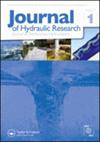Closure to “Influence of erosion on piping in terms of field conditions” by GIJS HOFFMANS, J. Hydraulic Res. 59(3), 512–522. 2020. https://doi.org/10.1080/00221686.2020.1786741
IF 1.7
3区 工程技术
Q3 ENGINEERING, CIVIL
引用次数: 1
Abstract
required on the distribution of flow to the pipe and polder or the magnitude of pipe discharges. Second, Bligh’s cases include a significant vertical seepage path, which makes it questionable to compare Bligh’s design rule directly to a model based on horizontal pipes. For many field conditions, the SD model predicts a higher strength (Hc) than Sellmeijer et al. (2011). The introduction of the Shields diagram by Hoffmans and Van Rijn (2018) to model the pipe resistance is considered as a step forward. On the other hand, the analyses show that the SD model assumptions regarding the distribution of groundwater flow to the pipe and the polder determine the scaling effects and hence the higher Hc for field conditions. The DgFlow simulations presented here do not support those assumptions. This Discussion also reveals the need for systematic experimental research into scale effects of backward erosion piping, not only effects on the average gradient but also on pipe geometry and pipe flow conditions.“管道冲蚀对管道性能的影响”[j] .水利水电工程学报,2009(3),522 - 522。2020. https://doi.org/10.1080/00221686.2020.1786741
要求对流向管道和圩田的流量分布或管道流量的大小。其次,Bligh的案例包括一个重要的垂直渗透路径,这使得将Bligh的设计规则直接与基于水平管道的模型进行比较是有问题的。对于许多现场条件,SD模型预测的强度(Hc)高于Sellmeijer等人(2011)。Hoffmans和Van Rijn(2018)引入Shields图来模拟管道阻力被认为是向前迈出的一步。另一方面,分析表明,SD模型对管道和圩田地下水流分布的假设决定了结垢效应,因此在现场条件下具有较高的Hc。这里提供的DgFlow模拟不支持这些假设。本文还揭示了对后冲管道尺度效应进行系统实验研究的必要性,不仅对平均梯度的影响,而且对管道几何形状和管道流动条件的影响。
本文章由计算机程序翻译,如有差异,请以英文原文为准。
求助全文
约1分钟内获得全文
求助全文
来源期刊

Journal of Hydraulic Research
工程技术-工程:土木
CiteScore
4.90
自引率
4.30%
发文量
55
审稿时长
6.6 months
期刊介绍:
The Journal of Hydraulic Research (JHR) is the flagship journal of the International Association for Hydro-Environment Engineering and Research (IAHR). It publishes research papers in theoretical, experimental and computational hydraulics and fluid mechanics, particularly relating to rivers, lakes, estuaries, coasts, constructed waterways, and some internal flows such as pipe flows. To reflect current tendencies in water research, outcomes of interdisciplinary hydro-environment studies with a strong fluid mechanical component are especially invited. Although the preference is given to the fundamental issues, the papers focusing on important unconventional or emerging applications of broad interest are also welcome.
 求助内容:
求助内容: 应助结果提醒方式:
应助结果提醒方式:


